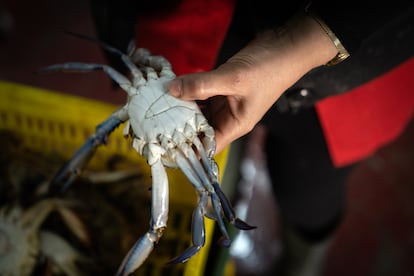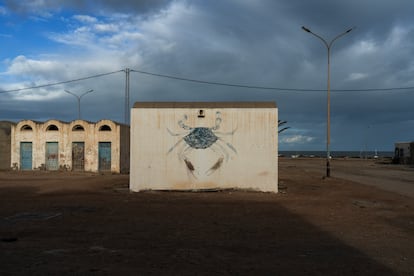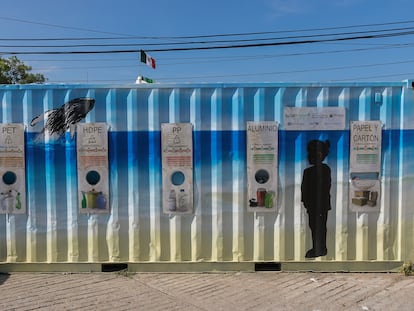The blue crab in Tunisia: From invasive threat to godsend
This crustacean, nicknamed Daesh, due to its predatory nature, left hundreds of small fishermen without a livelihood, but now generates thousands of jobs and boosts exports

The women are aligned around a long metal table. They examine the crustaceans one by one and arrange them in different piles according to the size. They pass then the piles to another table, where other workers armed with scissors cut the animals in two and place them neatly in cardboard boxes. “These ones go to Korea,” underlines with satisfaction Atif Athmi, the executive director of the factory. “In that country, the blue crab is considered a delicacy.”
Opened in 2020, the processing plant of the Jaradah fish group, in the industrial area of Gabès, is the largest in Tunisia and the outpost of a revolution that has transformed an ecological catastrophe into an opportunity for development.
Spotted for the first time in the Gulf of Gabès in 2014, the blue crab is an effect of the global warming that is particularly affecting the Mediterranean basin. “Native to the Indian Ocean, the Portunus Segnis arrived through the Suez Canal and found a suitable habitat in a warmer sea, which allowed it to proliferate,” explains Jamila Ben Souissi, research director at the Institut National Agronomique de Tunisie and expert in marine alien species.
Fishing is one of the pillars of the Tunisian economy and, together with agriculture, accounts for about 10% of GDP. So when the blue crab appeared on the coasts of the African country, it had the same impact as a tsunami. It devastated fish stocks and thrown fishermen out of business. It was soon nicknamed Daesh, an acronym for the fighters of the Islamic State, since it makes a clean sweep of everything in its way.
“At the beginning it was a tragedy. The crabs ate all the valuable fish and destroyed our nets with their claws,” recalls Sassi Alaya, head of the Groupement de développement de pêche, an association that brings together 600 fishermen in the Al Ghanouche area, near Gabès. “Many among us sold their boats because they didn’t see any future in the profession.”

But then there was a turning point. The blue crab has a highly prized meat, especially in Asia, the United States and Australia, which was the key to getting fishermen back to work and turning misfortune into business. The Tunisian government, supported by the U.N. Food and Agriculture Organization (FAO), began training sessions for local fishermen to show them the qualities of the dreaded crab. They were given special metal traps to catch the crabs more easily.
Within a few years, those same fishermen who had sold their boats bought new ones and started working again: the much-maligned Daesh became a highly sought-after raw material in the processing factories that sprouted up like mushrooms all over the Tunisian coast. Thus, a functioning supply chain was created, which today employs thousands of people: from fishermen to traders, from workers to logistics operators. “This has been a virtuous example of adaptive response to eco-systemic changes,” says Ben Souissi.
The researcher points out that today the situation has changed so much that the fishermen, who only nine years ago were alarmed by the arrival of the blue crabs, now fear their extinction due to overfishing and are asking for closed seasons and for a minimum catch size to be established by law.
In 2022, Tunisia exported 8,116 tonnes of blue crab, worth 90.5 million dinars (around $33 million), with a growth of 200% in just four years, according to the Minister of Agriculture, Water Resources and Maritime Fisheries. According to the Tunisian Ministry of Agriculture, blue crab meat is mainly exported to Vietnam, Spain, Malaysia, Italy and Thailand.
From invading shores to inspiring cook books
“This is a very promising market. Since we inaugurated the factory, we have never stopped increasing the quantities,” confirms Athmi. “We are thinking of opening other lines with new products, such as crab caviar, for example.”
Today in Tunisia there are 51 plants processing the blue crab, all created in the last five years. Investors from all over the world have thrown themselves on this godsend: the Gabès factory is owned by a group from Bahrain, which has a similar plant in the Persian Gulf country. Others factories belong to Koreans, Turks and Tunisian entrepreneurs.

While showing the production unites, the dozen of cold rooms and the area designated to receive the shellfish, Athmi discusses the mind-boggling numbers: “At the peak of the season in summer, we have 1,700 workers, mainly women, organized in three shifts. We can process up to 70 tons of crab per day.” The product, cooked or simply frozen, is packaged according to customers’ requests: Koreans love crab cut into two parts and prefer the female, in Thailand the raw ones are popular. Another factory in Zarzis, further South, has a production line that packages the pulp into tins, destined for the North American market.
Not only has the blue crab become an integral part of the fishing economy, it is also gaining room in Tunisian gastronomy. Ben Souissi shows with pride the recipe book that she has developed together with the women of the Kerkennah Islands, an archipelago off the coast of Sfax where the fishing community was particularly affected by the crustacean’s arrival. It is called From the Invasion to the Plate. “Last year, we organized on the islands a blue crab festival and served dishes where the traditional ingredients of Tunisian cuisine were replaced by this new component.” The photos that adorn the book show crab sandwiches or large plates of couscous in which the octopus is sided by this tropical crustacean. For the moment, these are still niche experiments. The blue crab is mainly intended for export. But in the future it could find greater diffusion in the Tunisian market.
To celebrate the blue crab and the wealth it has brought to the community, there are plans to build a sculpture of the crustacean in the main roundabout of Remla, the main urban center in the Kerkennah. “Yesterday we fished more squids and octopus. Today we fish the crab. The sea is changing, and we have to change accordingly,” says the fisherman Sassi Alaya.
Sign up for our weekly newsletter to get more English-language news coverage from EL PAÍS USA Edition
Tu suscripción se está usando en otro dispositivo
¿Quieres añadir otro usuario a tu suscripción?
Si continúas leyendo en este dispositivo, no se podrá leer en el otro.
FlechaTu suscripción se está usando en otro dispositivo y solo puedes acceder a EL PAÍS desde un dispositivo a la vez.
Si quieres compartir tu cuenta, cambia tu suscripción a la modalidad Premium, así podrás añadir otro usuario. Cada uno accederá con su propia cuenta de email, lo que os permitirá personalizar vuestra experiencia en EL PAÍS.
¿Tienes una suscripción de empresa? Accede aquí para contratar más cuentas.
En el caso de no saber quién está usando tu cuenta, te recomendamos cambiar tu contraseña aquí.
Si decides continuar compartiendo tu cuenta, este mensaje se mostrará en tu dispositivo y en el de la otra persona que está usando tu cuenta de forma indefinida, afectando a tu experiencia de lectura. Puedes consultar aquí los términos y condiciones de la suscripción digital.
More information
Últimas noticias
Most viewed
- Reinhard Genzel, Nobel laureate in physics: ‘One-minute videos will never give you the truth’
- Oona Chaplin: ‘I told James Cameron that I was living in a treehouse and starting a permaculture project with a friend’
- Pablo Escobar’s hippos: A serious environmental problem, 40 years on
- Why we lost the habit of sleeping in two segments and how that changed our sense of time
- Chevy Chase, the beloved comedian who was a monster off camera: ‘Not everyone hated him, just the people who’ve worked with him’










































